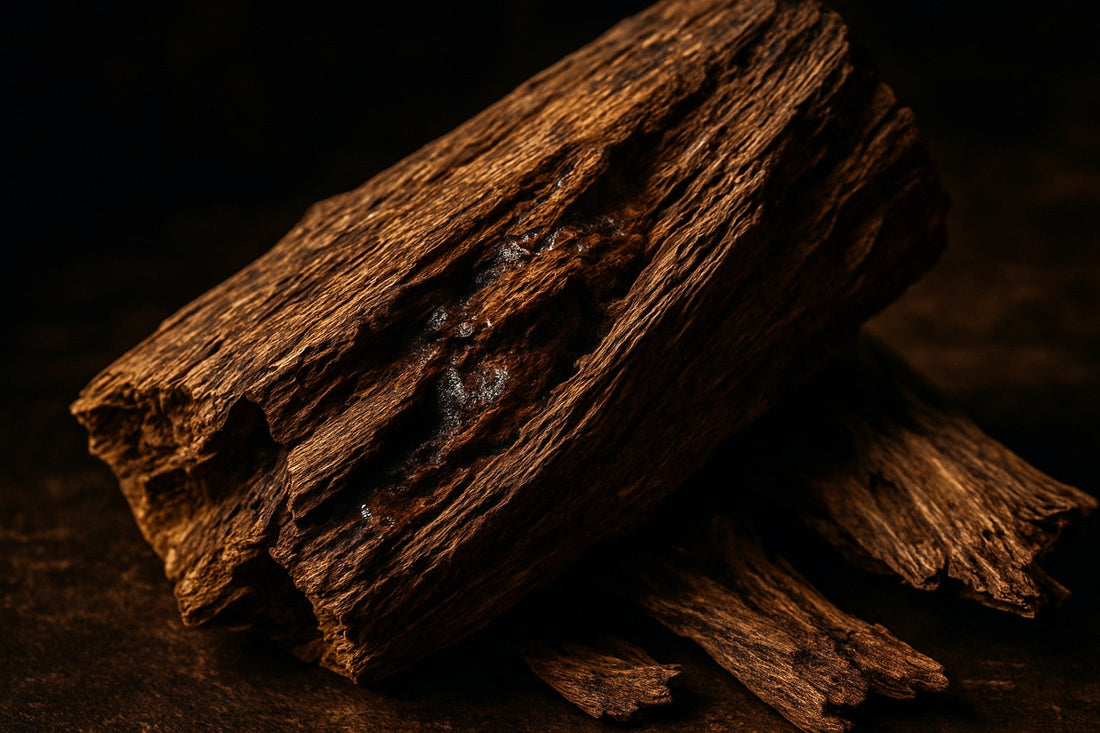
What Is Agarwood (Oud)? Discover the Scent Behind Luxury Incense
Rare, resinous, and deeply captivating, agarwood—also known as oud—is one of the world’s most precious incense ingredients. Its complex aroma and spiritual associations have made it a centrepiece of rituals, meditation, and luxury perfumery for centuries.
In this blog, we explore the fascinating story of agarwood, its unique formation, cultural significance, and why its scent is revered around the world.
What Is Agarwood?
Agarwood is a dark, fragrant resin that forms in the heartwood of Aquilaria trees (native to Southeast Asia) when they become infected with a specific type of mould. In response to the infection, the tree produces a resin to protect itself—this resin-soaked wood is what becomes agarwood.
Due to its rarity and the time it takes to form, agarwood is often referred to as “liquid gold” in the world of incense and perfume.
A Sacred Ingredient Across Cultures
Agarwood has held sacred value in many traditions:
- In Hinduism, agarwood is used in puja and offerings to deities.
- In Buddhism, it is burned for meditation and as an offering to the Buddha.
- In Islam, agarwood chips are burned as bukhoor in spiritual and social gatherings.
- In Japan, agarwood is used in Kōdō (“The Way of Fragrance”)—a refined incense ceremony.
- In Chinese culture, it is used in Taoist temples and traditional medicine.
Its rich, meditative smoke is seen as a bridge between earth and spirit, helping to clear energy and heighten awareness.
The Scent of Agarwood
Agarwood has a deep, woody, and sweetly balsamic aroma with subtle spicy, leathery, and floral notes. Its scent is often described as:
- Mysterious and grounding
- Warm, resinous, and complex
- Evolving over time, like fine wine
At SomaScents, we source agarwood responsibly and use it sparingly in sacred blends like:
- Smoke of Grace – A grounding, meditative blend for spiritual clarity
- Spice Temple – Where agarwood anchors a sacred, spicy atmosphere
Benefits of Agarwood in Incense
Aside from its exquisite aroma, agarwood carries powerful spiritual and wellness benefits:
1. Deepens Meditation
Its calming, grounding scent helps quiet mental noise and encourages introspection.
Reference: Tengku, M.A (2019). “Medical Benefits of Agarwood: A review.” Bioscience Research.
2. Enhances Spiritual Connection
In many traditions, agarwood is used to purify the space and invite divine presence or higher consciousness.
Reference: Sampson (2018). “History of Use and Trade of Agarwood.” Economic Botany.
3. Supports Emotional Healing
Its scent is believed to ease grief, anxiety, and emotional blockages, supporting energy flow in spiritual practices.
How to Use Agarwood in Incense
Agarwood can be used in different forms:
- Chips – Burned over charcoal (common in Middle Eastern traditions)
- Powder – Mixed with natural binders to make incense sticks or cones
- Oil – Used in luxury incense or for anointing
Because agarwood is so rich and potent, a little goes a long way. It’s often used as a base note to anchor lighter aromas in incense blends.
Rituals and Uses
You can use agarwood incense for:
- Evening meditations or breathwork
- Spiritual cleansing of your space
- Journaling or tarot rituals
- Moments of emotional release or reflection
Tip: Burn agarwood incense when you want to create a sacred space, even if it’s just for 10 minutes of stillness.
Ethical Consideration
Because agarwood is rare and overharvesting has endangered wild Aquilaria trees, SomaScents uses only ethically sourced, cultivated agarwood from sustainable farms. Supporting responsible harvesting protects the forests and the communities that rely on them.
Final Thoughts
Agarwood isn’t just an ingredient—it’s an experience. Each swirl of smoke invites you deeper into yourself, your breath, and the unseen energies that shape your space. Revered across centuries and continents, agarwood remains the soul of sacred incense.
